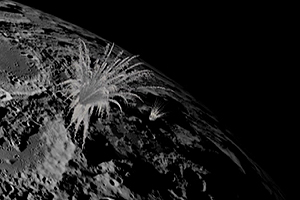 It may sound like Buck Rogers fantasy, but it's real. Scientists at NASA Ames Research Center in Mountain View are developing a spacecraft they will deliberately crash into the moon as part of an attempt to find water there.
It may sound like Buck Rogers fantasy, but it's real. Scientists at NASA Ames Research Center in Mountain View are developing a spacecraft they will deliberately crash into the moon as part of an attempt to find water there.
Early lunar missions found hydrogen, and scientists have speculated that there may be ice in the craters on the south side of the moon. If there is, it would provide a prime spot for astronauts to build a moon base. So, in 2008 NASA will launch a rocket toward the moon to look for it. One craft will break off and circle the moon. The other will smash into the moon's surface at 5,600 miles per hour, sending a plume of debris 40 miles high. At that point, the other craft will fly through the plume, taking measurements from infrared cameras to find the hydrogen. The plume will be so big that amateur astronomers should be able to see it with their telescopes from earth.
The robotic Moon missions are the first steps in NASA's plans to return astronauts to the Moon by 2018 as a steppingstone to going on to Mars. That's interesting. Equally interesting: who are these people and how do you get to be a demolition derby astrophysicist?
"Sea Otter Mystery and NASA's Rocket to the Moon" (episode #101) airs tonight on QUEST at 7:30pm on KQED 9, and KQED HD, Comcast 709. (full schedule)
You may also view the entire NASA Ames Rocket to the Moon segment online.
